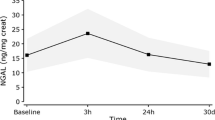Abstract
To evaluate the extent of renal parenchymal injury following high energy shock wave (HESW) application we measured the urine levels of two renal tubular brush border enzymes: leucine aminopeptidase (LAP) and γ-glutamyltranspeptidase (GGT) the day before, 24 hours and 7 days after extracorporeal shock wave lithotripsy (ESWL) in 23 patients. All patients had caliceal stones and were treated with a Dornier MPL 9000 lithotriptor under sedoanalgesia. Creatinine concentration of each sample together with total shock wave effect (TSWE) values were also assessed and comparatively evaluated with enzymuria levels.
Our results indicated a statistically significant rise in urinary excretion of both enzymes after 24 hours following lithotripsy (p<0.05). All these values returned to normal limits within 7 days after ESWL (p>0.05). Transient tubular damage due to HESW was found to be related to TSWE values assessed in our group.
Similar content being viewed by others
References
Lingeman, J. E., Newman, D., Mertz, J. H. O., Moshough, P. G., Steele, R. E., Kahnoski, R. J., Coury, T. A., Woods, J. R.: ESWL; The Methodist Hospital of Indiana experience.J. Urol., 135, 1134 (1986).
Karlin, S. G., Schulsinger, D., Urivetsky, M., Smith, A. D.: Absence of persisting parenchymal damage after ESWL as judged by excretion of renal tubular enzymes.J. Urol., 144, 13 (1991).
Recker, F., Hofmann, W., Bex, A., Tscholl, R.: Quantitative determination of urinary marker proteins: A model to detect intrarenal bioeffects after ESWL.J. Urol., 148, 1000 (1992).
Kande, J. V., Williams, C. M., Millner, M. R., Scott, K. N., Finlayson, B.: Renal morphology and function immediately after ESWL.AJR, 145, 305 (1985).
Karlsen, S. J., Berg, K. J.: Acute changes in kidney function following ESWL for renal stones.Br. J. Urol., 67, 241 (1991).
Williams, C. M., Kaude, J. C., Miles, S. G.: The incidence of stones, decreased renal function and hypertension after ESWL: A long-term follow-up study.J. Nucl. Med., 28, 764 (1987).
Recker, F., Rubben, H., Bex, A., Costantinidis, C.: Morphological changes following ESWL in the rat kidney.Urol. Res., 17, 229 (1989).
Kishimoto, T., Senju, M., Sugimoto, T., Yamamoto, K.: Effect of high energy shock wave exposure on renal function during extracorporeal shock wave lithotripsy for kidney stones.Eur. Urol., 18, 290 (1990).
Bedük, Y., Erden, I., Göĝüş, O., Sarica, K., Aytaç, S., Karalezli, G.: Evaluation of renal morphology and vascular function by color flow doppler sonography immediately after ESWL.J. Endourol., 7, (6), 457 (1993).
Jung, K., Brieng, M., Kirschner, P., Schroder, K., Schmiedel, T.: Excretion of urinary enzymes after ESWL.Tech. Br. Clin. Chem., 33, 2000 (1989).
Hasegawa, S., Kato, K., Takashi, M., Zhu, Y.: S100Ao protein as a marker for tissue damage related to extracorporeal shock wave lithotripsy.Eur. Urol., 24, 393 (1993).
Jung, K., Kirschner, P., Wille, A., Brien, G.: Excretion of urinary enzymes after extracorporeal shock wave lithotripsy: A critical reevaluation.J. Urol., 149 1409 (1993).
Metz, U., Graben, N., Maruhn, D., Bock, K.: Urinary enzyme excretion after single dose of phenacetin and paracetamol (acetaminophen) during antidiuresis and during water diuresis.Clin. Chem. Acta, 160, 151 (1986).
Raab, P. W.: Diagnostic value of urinary enzyme determination.Clin. Chem., 188, 5 (1972).
Patterson, E. K., Hsiao, S. H., Keppel, A.: Studies on dipeptidases and aminopeptidases: Distinction between leucine aminopeptidase and enzymes that hydrolyse 1-leucyl-β-naphthylamide.J. Biol. Chem., 238, 361 (1963).
Knapp, P. M., Scott, J. W.: Magnetic resonance imaging following ESWL.J. Urol., 137, Abstract 732 (1987).
Szasz, G.: γ-Glutamyltranspeptidase Aktivität im Urin.Z. Klin. Chem. Klin. Biochem., 8, 1 (1970).
Johnston, I. D., Norman, F., Scable, J., Yuen, C. T., Price, R. G.: The diagnostic value of urinary enzyme measurements in hypertension.Clin. Chem. Acta, 133, 317 (1983).
Jung, K., Schulze, G., Reinholdt, C.: Different diuresis-dependent excretions of urinary enzymes: N-acetyl-D-glucosaminidase, alanine aminopeptidase, alkaline phosphatase and γ-glutamyltransferase.Clin. Chem., 32 (3), 529 (1986).
Kishimoto, T., Yamamoto, K., Sugimoto, T.: Side effects of ESWL exposure in patients treated by ESWL for upper urinary tract stones.Eur. Urol., 12, 308 (1986).
Weber, A., Köhrmann, K. U., Kahmann, F. U., Rassweiler, J., Alken, P.: Lithotriptorenvergleich anhand eines standardisierten in-vitro Steinmodels.Z. Urol., 4, 170 (1992).
Whelan, J. P., Finlayson, B.: An experimental model for the systematic investigation of stone fracture by ESWL.J. Urol., 140, 395 (1988).
Author information
Authors and Affiliations
Rights and permissions
About this article
Cite this article
Sarica, K., Süzer, O., Yaman, Ö. et al. Leucine aminopeptidase enzymuria: Quantification of renal tubular damage following extracorporeal shock wave lithotripsy. International Urology and Nephrology 28, 621–626 (1996). https://doi.org/10.1007/BF02552155
Accepted:
Issue Date:
DOI: https://doi.org/10.1007/BF02552155




